![]()
![]()
![]()
Use LEFT and RIGHT arrow keys to navigate between flashcards;
Use UP and DOWN arrow keys to flip the card;
H to show hint;
A reads text to speech;
96 Cards in this Set
- Front
- Back
|
momentum
|
Ft = mv-mu
F = (mv-mu)/t = m(v-u)/t = ma impulse = change in momentum |
|
|
rebound momentum
|
2mu only if the speed of impact is t equal to the speed of rebound
|
|
|
momentum in an explosion
|
total momentum is 0
when direction is taken account of |
|
|
circular motion F=
|
centripetal force
acting towards centre mv^2/r mω^2r |
|
|
circular motion v=
|
straight line velocity
2πr/T 2πrf ωr |
|
|
angular speed w=
|
amount of angle travelled per second
2πf 2π/T |
|
|
centripetal acceleration a=
|
the acceleration towards the centre of motion
v^2/r ω^2r |
|
|
circular motion positive direction ?
|
towards centre
|
|
|
car on banked track v=
|
v^2 = gr tanθ
(N+N)sinθ = mv^2/r (N+N)cosθ = mg (N+N)sinθ / (N+N)cosθ = v^2/rg tanθ = v^2/rg |
|
|
amplitude
|
maximum displacement from the equilibrium point
|
|
|
Time period
|
time to complete one full cycle (seconds)
|
|
|
Frequency
|
the amount of cycles/ oscillations in one second (Hz)
|
|
|
phase difference
|
2πΔt/T
must be in radians |
|
|
simple harmonic motion
|
acceleration is always opposite to direction of displacement
a = -kx a = -(2πf)^2 x undamped system |
|
|
Time period / frequency of simple harmonic motion
|
T = 2π sqrt(l/g)
T = 2π sqrt(m/k) |
|
|
energy of simple harmonic motion
|
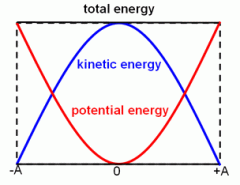
total energy is always constant
|
|
|
energy stored in a spring
|
0.5kx^2
|
|
|
resonance
|
when the periodic force is applied at the natural frequency
phase difference of π/2 |
|
|
Bartons pendulums
|
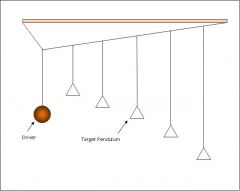
target pendulum is in resonance π/2 out of phase
shorter π/2 out of phase longer π out of phase |
|
|
radial field
|
field lines like spokes on a wheel directed to the centre
|
|
|
uniform field
|
same magnitude and direction throughout the field
parallel field lines |
|
|
gravitational potential
work = |
mass (m) x potential (v)
therefore potential is the work per unit mass or energy per unit mass |
|
|
gravitational potential (v) unit
|
J/kg
|
|
|
gravitational field
|
force per unit mass
|
|
|
equipotential gradients
|
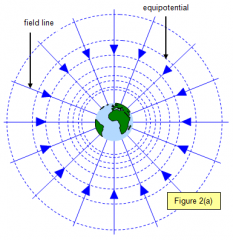
lines where the potential of the field are equal
|
|
|
potential gradient
|
change of potential per metre at that point
Δv/Δr |
|
|
connect g and V
|
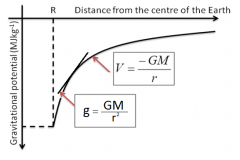
g is the gradient of v
therefore Δv/Δr = g |
|
|
gravitational force
|
F = G Mm/r^2
|
|
|
gravitational field against distance
|
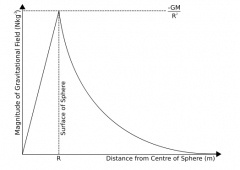
g = GM/r^2 as long as r is larger than the radius of the body
|
|
|
geostationary satellites
T = |
24 hours
86400 seconds |
|
|
electric field direction
|
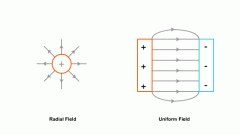
positive to negative
|
|
|
electric field vector or scaler
|
vector
|
|
|
electric field strength
|
force per unit charge
E = F/Q |
|
|
density of field lines show
|
the strength of the field
|
|
|
electric potential
|
work done per unit charge to move it from infinity to that point in the field
|
|
|
unit of electric potential
|
Volt (v)
1 J/C |
|
|
(electric) energy can be calculated as
|
Voltage x charge
|
|
|
electric potential and electric field strength connection
|

the electric field is the gradient of the electric potential
|
|
|
equipotential of electric fields
|

can be a 0 point where there is no potential
|
|
|
coulombs law
|
F = k Qq/r^2
k = 1/4πε |
|
|
electric field definition
|
force per unit charge
|
|
|
compare force of gravitational field and electric fields
|
F = GMm/r^2 = Qq/4πεr^2
|
|
|
compare field strength of gravitational field and electric fields
|
g = F/m E = F/q
|
|
|
compare units of gravitational field and electric fields
|
N/kg or m/s^2
N/C or V/m |
|
|
compare units of potential of gravitational field and electric fields
|
J/kg Volts (J/C)
|
|
|
radial gravitational field
|
g = GM/r^2
v = -GM/r |
|
|
radial electric field
|
E = Q/4πεr^2
v = Q/4πεr |
|
|
capacitor
|
a device designed to store charge with two metal plates separated by an insulator
|
|
|
charge on a capacitor
|
charge = current x time
C = C/S x S |
|
|
how to measure capacitance
|
charge a capacitor through a variable resistor, by varying the resistance keep the current constant. Multiply the current by the time, plot charge against the voltage which is measured through a volt metre on the capacitor. to find the capacitance find the gradient Δq/Δv
|
|
|
capacitance
|
the charge stored per unit pd
|
|
|
energy stored in a capacitor
|
E = 0.5QV = 0.5CV^2 = 0.5(Q^2)/c
Area under a voltage charge graph |
|
|
capacitor discharge
|
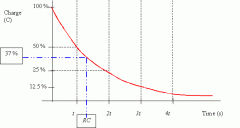
Q = Qe^(-t/RC)
V = Ve^(-t/RC) I = Ie^(-t/RC) |
|
|
Time constant
|
RC
Resistance x capacitance |
|
|
Capacitor charging
|

the charge will go up making the resistance of the capacitor higher so the current will drop
|
|
|
magnetic flux density
|
B - strength of the magnetic field
force per unit length per unit current on a current carrying conductor at right angles to the magnetic field lines |
|
|
flemings left hand rule
|
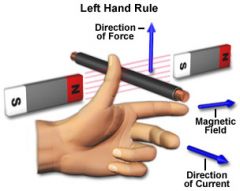
thumb - force
index - field middle - current |
|
|
force of a magnetic field
|
F = bIl
|
|
|
simple electric motor
|
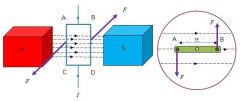
the current is in a different direction on both sides of the coil so the force is in different directions.
a split ring communicator is needed so the current will change direction on the sides of the wire to i will spin the same direction |
|
|
unit of magnet it field B
|
Tesla T or wb/ or NS/Cm
|
|
|
magnetic flux
|
magnetic flux density x area
BA |
|
|
magnetic flux linkage
|
magnetic flux density x area x number of coils
BAN |
|
|
force on a moving charge
|
F = BQv
|
|
|
radius of charge in magnetic field
|
BQv = mv^2 /r
r = mv/BQ |
|
|
Thermionic emission
|
heated metal will give of electrons
|
|
|
what happens when a wire is moved in a magnetic field
|
an emf is produced
|
|
|
emf produced when ?
|
when there is relative motion between the magnetic field and a conductor
|
|
|
dynamo rule
|
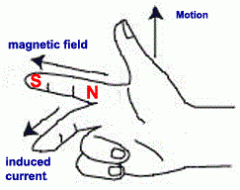
thumb - motion
index - field middle - induced current |
|
|
lenz's law
|
the direction of the induced current is always such as to oppose the change that causes the current
|
|
|
Faradays law of electromagnetic induction
|
induced emf in a circuit is equal to the rate of change of flux linkage through the circuit
|
|
|
emf
|
emf = -N ΔΦ/Δt
|
|
|
transformer equation
|
Np/Ns = Vp/Vs = Is/Ip
|
|
|
how are transformers made more efficient
|
core to make the field lines go through the second coil
laminated coil to reduce eddy currents |
|
|
efficiency of a transformer
|
IsVs/IpVp x 100
|
|
|
grid system
|
high voltage low amps
alternating current so magnetic field changes so transformers can be used |
|
|
rutherford experiment
|
alpha particles shot at gold foil (all same kinetic energy) 1 in 2000 are deflected
1 in 10000 deflected over 90 degrees nucleus contains most mass and is positively charged |
|
|
gold foil in alpha scattering need's to be
|
thin to stop double scattering and to let alpha particles through
|
|
|
alpha particle in cloud chamber
|
all easily visible and the same length showing they all have the same kinetic energy
|
|
|
β particles in cloud chamber
|
wispy tracks that are easily deflected by air molecules, not as easy to see because β particles are less ionising
|
|
|
intensity of gamma source
|
k/r^2
nhf/4πr^2 |
|
|
activity of radioactive source
|
number of nuclei that disintegrate per second
|
|
|
unit of activity
|
becquerel Bq
|
|
|
alpha and beta emission on NZ graph
|
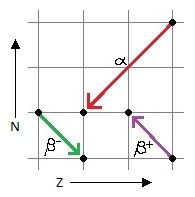
alpha - looses two N, looses two P
Beta minus - Gains P, looses N Beta plus - looses P, Gains N |
|
|
metastable state
|
gamma photon must be emitted to get to ground state
|
|
|
binding energy
|
work that must be done to separate a nucleus into its constituent particles
|
|
|
mass defect
|
difference between the mass of separated nucleons and the nucleus
|
|
|
internal energy
|
sum of kinetic energy's and potential energy's of molecules
|
|
|
Celsius - kelvin
|
Celsius = kelvin - 273.15
Celsius + 273.15 = Kelvin |
|
|
specific heat capacity Q =
|
mcΔt
|
|
|
specific heat capacity
|
the amount of energy to raise the temperature of a unit mass by 1 kelvin without changing the state
|
|
|
latent heat graph
|
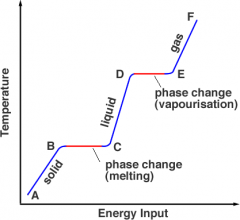
during phase change there is energy input but no heat change
|
|
|
latent heat of fusion
|
energy needed to melt a solid at it's melting point
|
|
|
latent heat of vaporisation
|
the energy needed to vaporise a liquid at it's boiling point
|
|
|
specific latent heat of fusion
|
energy needed to change the state of unit mass of a substance from solid to liquid without temperature change
|
|
|
specific latent heat of vaporisation
|
the energy needed to change the state of unit mass of a substance from liquid to vapour without change in in temperature
|
|
|
kinetic theory temperature
|
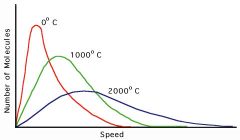
|

